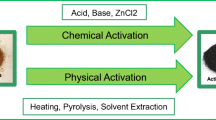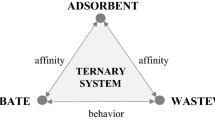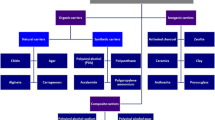Summary
The degradation rate of hydrocarbons in oily sludge obtained from a flotation unit by free and immobilized cells in shaking flasks and in a stirred tank reactor was investigated. For the biodegration of 3.3% hydrocarbons free cells and cells immobilized on granular clay were used. Free cells needed 7–8 weeks to use 30% of the 3.3% hydrocarbons, whereas with immobilized cells the same result was obtained after 3–4 weeks only. In shaken flasks with high hydrocarbon concentrations (8%), immobilized Candida parapsilosis degraded 90% of the hydrocarbons in the oily sludge within 3 weeks, while free cells degraded only 27.5% in the same period. In degradation experiments with a bioreactor, free and immobilized cells of the isolate ISO-OS BÜ 20 showed better results compared to cultures in shaken flasks due to better aeration and mixing. Free cells degraded 50% of the 5% hydrocarbon-containing oily sludge in 7 weeks, whereas immobilized cells gave the same result after only 4 weeks.
Similar content being viewed by others
References
Atlas RM (1981) Microbial degradation of petroleum hydrocarbons: an environmental perspective. Microbiol Rev 45:180–198
Bartha R (1986) Biotechnology of petroleum pollutant biodegradation. Microbiol Ecol 12:155–161
Blazevic DJ, Koepcke MH, Matsen JM (1973) Incidence and identification of Pseudomonas flourescens and Pseudomonas putida in the clinical laboratory. Appl Microbiol 25:107–110
Bluestone M (1986) Microbes to the rescue. Chem Weekbl 139:34–36
Bossert I, Bartha R (1984) The fate of petroleum in soil ecosystems. In: Atlas RM (ed) Petroleum microbiology. Macmillan, New York, pp 435
Brodsky MH, Nixon MC (1973) Rapid method for detection of Pseudomonas aeruginosa on MacConkey agar under ultraviolet light. Appl Microbiol 26:219–220
Brown KW, Donnelly KC, Deuel LE (1983) Effects of mineral nutrients, sludge application rate, and application frequency on biodegradation of two oily sludges. Microb Ecol 9:363–373
Brown KW, Deuel LE, Thomas JC (1985) Distribution of inorganic constituents in soil following land treatment of refinery wastes. Water Air Soil Pollut 25:285–300
Büdecker UW (1988) Abbau ölhaltiger Schlämme mit immobilisierten Mikroorganismen. Diploma, Westfälische Wilhelms-Universität, Münster
Concawe (1981) Revised inland oil spill clean-up manual. (Report 7/81) Concawe, The Hague
Crawford RL, Mohn WW (1985) Microbiological removal of pentachlorophenol from soil using a Flavobacterium. Enzyme Microb Technol 7:617–621
Edgehill RU, Finn RK (1983) Microbial treatment of soil to remove pentachlorophenol. Appl Environ Microbiol 45:1122–1126
Ehrhardt HM, Rehm HJ (1985) Phenol degradation by microorganisms adsorbed on activated carbon. Appl Microbiol Biotechnol 21:32–36
Etienne-Berumen G, Hebrero-Rodriguez J, Garduno-Ochoa RA, Salazar-Marrero P (1983) Microbial degradation of hydrocarbons experiments for evaluating its applicability in recovering soils contaminated with crude petroleum. (14th National Congress of Microbiology) Rev Latinoam Microbiol 25:55–61
Fujisawa H, Murakami M (1985) Ecological studies on hydrocarbon oxidizing bacteria in Japanese coastal waters. 6. Screening method of heavy oil decomposing bacteria in the sea. J Shimonoseki Univ Fish 30:13–24
Ismailov NM (1985) Biodegradation of oil hydrocarbons in soil inoculated with Candida. Mikrobiologia 54:835–841
King EO, Ward MK, Raney DE (1954) Two simple media for the demonstration of pyocyanin and flourescein. J Lab Clin Med 44:301–307
Massie LC, Ward AP, Davies JM (1985) The effects of oil exploration and production in the northern north sea. 2. Microbial biodegradation of hydrocarbons in water and sediments 1978–1981. Mar Environ Res 15:235–262
Michelcic JR, Luthy RG (1988) Degradation of polycyclic aromatic hydrocarbon compounds under various redox conditions in soil-water systems. Appl Environ Microbiol 54:1182–1187
Mille G, Chen YY, Giusti G, Don H, Vacelet E, Le Campion-Asumard T, Plante-Cuny MR (1984) The evolution of hydrocarbons by bacterial and microphytic populations in sediments of the maritime marshes of the Ile Frande France polluted by the Amococadiz: 1. Evolution of hydrocarbons and bacteria. Mar Environ Res 11:213–232
Morgan P, Watkinson RJ (1989) Hydrocarbon degradation in soils and methods for soil biotreatment. CRC Crit Rev Biotechnol 8:305–333
Mörsen A, Rehm HJ (1987) Degradation of phenol by a mixed culture of Pseudomonas putida and Cryptococcus elinovii adsorbed on activated carbon. Appl Microbiol Biotechnol 26:283–288
Mörsen A, Rehm H-J (1990) Degradation of phenol by defined mixed culture immobilized by adsorption on activated carbon and sintered glass. Appl Microbiol Biotechnol: (in press)
Moursy AS, El-Agaby MM (1982) Microbial degradation of hydrocarbons in Ismailia Egypt Canal water. Environ Int 7:423–428
Neumüller O-A (1979 ff) Römpps Chemie-Lexikon, 8th edn. Franckh'sche Verlagsbuchandlung, Stuttgart
Omar SH, Rehm HJ (1988) Degradation of n-alkanes by Candida parapsilosis and Penicillium frequentans immobilized on granular clay and aquifer sand. Appl Microbiol Biotechnol 28:103–108
Oudut J, Fusey P, Abdelouahid DE, Haloui S, Roquebert MF (1987) Degradation capactity of bacteria and fungi isolated from soil contaminated by fuel. Can J Microbiol 33:232–243
Rybak VK, Ovcharova EP, Koval EZ (1984) Mycoflora of oil-polluted soil. Mikrobiol Zh (Kiev) 46:29–32
Sanders PF, Tibbetts PJ (1987) Effects of discarded drill muds on microbial populations. Philos Trans R Soc Lond [Biol] 316:567–585
Valo R, Salkinoja-Salonen M (1986) Bioreclamation of chlorophenol contaminated soil by composting. Appl Microbiol Biotechnol 25:68–72
Westmeier F, Rehm HJ (1986) Einsatz von Immobilisationsverfahren zum biologischen Abbau chlorierter Phenole. Chemische Industrie 38:158–160
Westmeirr F, Rehm HJ (1987) Degradation of 4-chlorophenol in municipal wastewater by adsorptive immobilized Alcaligenes sp. A7–2. Appl Microbiol Biotechnol 26:78–83
Author information
Authors and Affiliations
Additional information
Offprint requests to: H.-J. Rehm
Rights and permissions
About this article
Cite this article
Omar, S.H., Büdecker, U. & Rehm, HJ. Degradation of oily sludge from a flotation unit by free and immobilized microorganisms. Appl Microbiol Biotechnol 34, 259–263 (1990). https://doi.org/10.1007/BF00166792
Received:
Accepted:
Issue Date:
DOI: https://doi.org/10.1007/BF00166792




